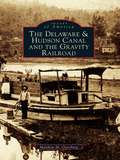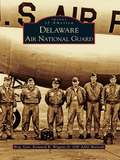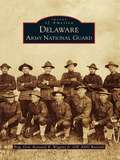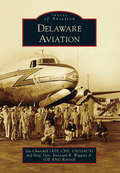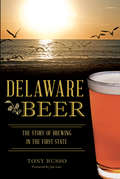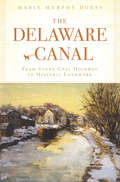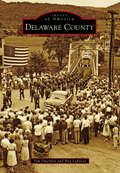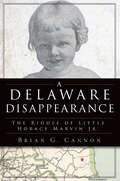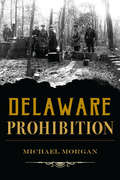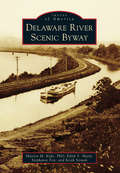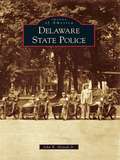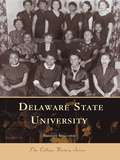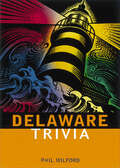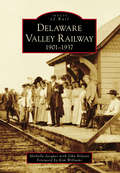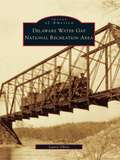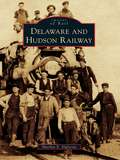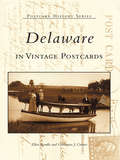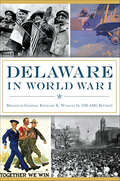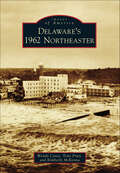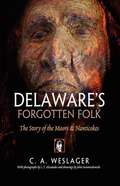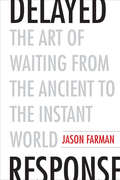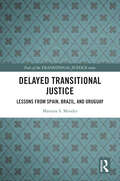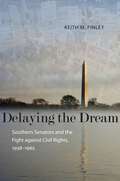- Table View
- List View
Delaney's Crossing
by Jean BarrettVirile, womanizing Cooper J. Delaney was Agatha Pennington's only hope to help lead a group of destitute women to Oregon, where the promise of a new life awaited them. He was a man as harsh and hostile as the vast wilderness-- but Agatha counted on a gentleness she sensed behind his hard-muscled exterior, a tenderness lurking beneath his gruff facade. Tricked by Agatha into leading the women, at first Delaney couldn't wait to get away from the prim-and-proper old maid. But as the group battled rainstorms, renegade Indians, and raging rivers, the tall beauty's tenacity never wavered. And with each passing mile. Cooper realized he was struggling against a maddening attraction for her--until he decided, much to his surprise, that he would journey to the ends of the earth if only he could claim her untouched heart.
Delaware & Hudson Canal and the Gravity Railroad, The (Images of America)
by Matthew M. OsterbergFrom the anthracite mines of Pennsylvania at Carbondale to the Hudson River in New York near Kingston, the Delaware & Hudson Canal Company and the Gravity Railroad transformed long tracks of wilderness into thriving economic areas. Conceived as an inexpensive way to transport anthracite coal, the canal began hauling loads in 1828 to the Hudson River, where barges to New York City took over. A leader in the technologies of the time, the canal company used the first telegraph system in America, and when Delaware & Hudson engineer Horatio Allen ran the locomotive Stourbridge Lion in Honesdale, he became the first to run a commercial steam locomotive on tracks in the Western Hemisphere. The Delaware & Hudson Canal was privately funded, and when stock was offered for sale in 1825, it soon became the first American company capitalized at $1 million. The Delaware & Hudson Canal and the Gravity Railroad uses fascinating vintage photographs to tell an amazing piece of American history. It shows the mules, the canal boats, the locomotives, and the men who ran this technological wonder, boasting one hundred eight locks over one hundred eight miles, plus four suspension aqueducts built by John A. Roebling of Brooklyn Bridge fame. The Gravity Railroad is shown as well, hauling coal from Carbondale to Honesdale over the Moosic Mountains, a rise of more than one thousand feet. The Delaware & Hudson Canal and the Gravity Railroad tells the story of an American industrial masterpiece.
Delaware Air National Guard (Images of America)
by Brig Gen Wiggins Jr.The Delaware Air National Guard got its start when a group of World War II veterans formed a new National Guard unit composed of surplus airplanes, combat experience, a measure of hard work, camaraderie, and fun. Some called this assemblage a gentleman's flying club, but in a few short years, it was tested for the first time in the Korean War. Since then, the Delaware Air National Guard has flown and fought in almost every corner of the globe. It answered the call in Vietnam, the Middle East, the Balkans, and most recently in Iraq and Afghanistan. Celebrating 60 years of service, it has become a well-known local institution. The "Blue Hen Air Force" has evolved into a professional organization that shoulders a significant operational role for the U.S. Air Force and serves as a versatile emergency resource for the state of Delaware.
Delaware Army National Guard (Images of America)
by Brig Gen Wiggins Jr.The Delaware National Guard traces its roots to 1655, when the Swedish Colonial government formed a militia to defend itself. That tradition carried through Dutch and then English control of the colony. The militia served in all five French and Indian Wars and then distinguished itself during the Revolutionary War as the First Delaware Regiment of the Continental Army, earning its "Blue Hen" nickname. The Delaware militia continued to serve in every major war, and currently it remains in the forefront. Images of America: Delaware Army National Guard presents images of this fabled organization that survived from the Spanish-American War to the present. The people, places, equipment, and facilities of the Delaware National Guard are illustrated in this compilation of historic photographs from the collection of the Delaware Military Heritage and Education Foundation.
Delaware Aviation (Images of Aviation)
by Brig. Gen. Wiggins Jr. Jan ChurchillFor such a small state, Delaware has a fascinating aviation history. Delaware counts aircraft from the smallest, like the 1910 Delaplane, to the largest, the USAF C-5 Galaxy airlifter, among its rich variety. Numerous small grass airstrips dotted the state in the early years, serving as an incubator for aerial progress. The state has been a home to aircraft manufacturers, notable aviators, and aeronautical innovators and hosts military aviation units from the Army National Guard, the Air National Guard, the US Air Force, and the Air Force Reserve on two major bases. World War II brought the development of Dover Air Force Base, currently the largest aerial superport in the United States. This collection of historical photographs depicts the colorful people, the locales, the varied aircraft, and the milestone events that make up the history of aviation in Delaware.
Delaware Beer: The Story of Brewing in the First State (American Palate)
by Tony Russo Jim LutzBoasting a brewing history older than the United States, Delaware packs an outsized punch in the craft beer scene with its landmark breweries and bold flavors. In 1873, the German lagers of Wilmington's Diamond State brewing rose to dominance. After Prohibition and the bust of the first craft beer bubble, entrepreneurial homebrewers resurrected the industry. Sam Calagione of Dogfish Head led the charge by rewriting the state's beer legislation, and the field opened to other brewpubs like Stewart's and Iron Hill to pair savory bites with their brews. By 2009, production breweries like 16 Mile and Fordham & Dominion were on the rise, changing the arc of Delaware beer. Beer writer Tony Russo tells a story of big risks and innovative brewers and proves that there has never been a better time to drink local.
Delaware Canal, The: From Stone Coal Highway to Historic Landmark
by Marie Murphy DuessVault aboard a hinge boat with Marie Duess as she nimbly navigates the historic waters of the Delaware Canal. Any ramble along the now-serene Pennsylvania waterway will show you why its beauty inspired so many famous brushstrokes. But only on a voyage with Duess will you dock at hidden places that doubled as underground railroad stops and Prohibition-era speakeasies and witness the inventive genius of Josiah White and the instinct and muscles of the endearing mules that hauled the nation into the Industrial Revolution. By journey's end, you will be reluctant to part with your newfound boatmates after looking into the hopeless eyes of five-year-old mine laborers and listening to the rousing choruses of boat captains who poured a hearty lifetime into steering coal from Easton to Bristol.
Delaware County: A Catskill Land And Its People, 1791-2007 (Images of America)
by Tim Duerden Ray LafeverDelaware County is located in New York's Catskill Mountains, a region well known as a vacation spot for urbanites. Early settlers farmed the hillsides and valleys, while others sought the raw materials in the forests. By 1797, the population had increased, so the region officially became known as Delaware County. By the 1880s, the county comprised 19 towns, the same number as today. It was around that time when dairy farming became the mainstay of the local economy. However, during the last half century, traditional dairying has declined, and a great deal of agricultural land has been bought up by those seeking an escape from the city. New York City residents' need for fresh water has resulted in the construction of two 20th-century reservoirs within Delaware County's borders and the inundation of several communities. Meanwhile, the waters and the forests have remained, continuing to enrich the county by providing sustenance and comfort.
Delaware Disappearance, A: The Riddle of Little Horace Marvin Jr. (True Crime)
by Brian G. CannonIn early March 1907, young Horace Marvin Jr., just a few weeks shy of his fourth birthday, was playing in the yard of his father's new farm in a sparsely populated area near Dover, Delaware. The family had just moved from Iowa, and this was the first day Horace had to explore their new home. In the farmyard with Horace were his brother John and cousin Rose, all visible to neighbors helping the previous owner move off the farm. Then Horace disappeared without a trace. Within two weeks, this heartbreaking event was being reported to hundreds of other families in newspapers across the country and around the world. Young Horace's disappearance would be the most publicized missing child story until the Lindbergh kidnapping exactly twenty-five years later. Local author Brian G. Cannon tells the full story of this tragedy for the first time.
Delaware Prohibition (True Crime)
by Michael MorganProhibition attempted to kill John Barleycorn, the personification of intoxicating drinks, but in Delaware the notice of his death was premature. Government agents tried in vain to stop bootleggers and rumrunners, who fed the speakeasies that quenched the thirst of the people of the First State. Against the backdrop of the Roaring Twenties, bootleggers sped up and down the new Du Pont Boulevard, while enforcement agents, such as the Bible-thumping "Three Gun" Wilson, tried in vain to stop them. The stock market crash and the Great Depression ended dry laws and brought about the resurrection of Barleycorn. Local author Michael Morgan recounts the dramatic tales of this unique period of Delaware history.
Delaware River Scenic Byway
by Keith Strunk Marion M. Kyde Edith S. Sharp Stephanie FoxThe river, the road, the rails, and the ribbon of canal--these four parallel transportation arteries define the historic corridor that is the Delaware River Scenic Byway. From the French and Indian Wars and the definitive Battle of Trenton in the colony of New Jersey to the mule-drawn barges, river steamboats, and puffing steam engines of the coal-fired Industrial Revolution, this corridor supported the formation and growth of the country. From the barracks and battlefields of Trenton to the mills and farms of Prallsville and Frenchtown, the modern visitor can trace an explosion of invention and ingenuity. Delaware River Scenic Byway showcases the rich industrial, commercial, and recreational history of this landmark New Jersey roadway.
Delaware State Police (Images of America)
by John R. Alstadt Jr.April 28, 1923, marks the birth of the Delaware State Police. Discussions occurred as early as 1906 for a statewide police organization to cope with speeding automobiles, roving bands of troublemakers, and the ever-present bootleggers. Prohibition and the 18th Amendment brought the discussion to the forefront. With the hiring of Charles J. McGarigle and Joseph A. McVey, the Delaware Highway Police Department came to fruition on January 1, 1920. Using many never-before-published photographs from the Delaware State Police Museum archive, Images of America: Delaware State Police illustrates the storied past of the Delaware State Police from 1920 to 1985.
Delaware State University
by Bradley SkelcherSince its founding in 1891, Delaware State University has proven to be an influential leader in the campaign for equal and quality higher education for students coming from disadvantaged backgrounds in the state of Delaware. Originally the State College for Colored Students, the school was established in response to the Second Morrill Land Grant Act, which required states to allow African Americans entrance into state colleges or to create separate schools for such students. Born in the age of segregation, this proud institution has weathered the storms of over a century and, with vision and persistence, transformed itself into a highly regarded, four-year university. Containing over two hundred black-and-white photographs, Delaware State University tells the remarkable story of a beloved college. The faces and deeds of faculty and students--from professional athlete John Taylor to Ambassador Jerome Holland, from Civil Rights activist Ethel Belton to jazz great Clifford Brown--are depicted in this volume, as well as historical events that came to bear on university life, such as the training of pilots through the Civilian Pilot Training Program and the desegregation that stemmed from the Civil Rights Movement. Reflecting the changing landscape of American society, Delaware State University continues to reinvent itself and endeavors, always, to instill in its students the truth that "Only the Educated are Free."
Delaware Trivia
by Phil MilfordFun facts about the first state!Delaware Trivia is the ultimate quiz book on the great state of Delaware. This updated and revised edition provides hours of entertainment and education about America’s first (and second-smallest) state with Q&As on:HistoryGeographyFamous FiguresNatureLiteratureand more
Delaware Valley Railway: 1901-1937 (Images of Rail)
by Foreword By Williams Michelle Jacques BeljeanFrom 1901 to 1937, the lone engine of the Delaware Valley Railway chugged up and down its solitary track, from the Stroudsburgs to Bushkill. It was a time of heady prospects as the resorts of the Delaware Water Gap pushed north up the valley. Modest farmhouses became vacation boardinghouses, and some then blossomed into grand hotels. The railway brought in vacationers by the carload, but it was not just about tourism. The dinkey hauled in coal for winter heat and hauled out lumber, dairy, and farm produce that kept the farmers in cash. Farm children commuted to town to earn their high school degrees. For more than a generation, the dinkey’s whistle blowing over the valley linked its people and places.
Delaware Water Gap National Recreation Area (Images of America)
by Laura ObisoEuropeans first settled in what was to become the Delaware Water Gap National Recreation Area (DWGNRA) in the 17th century. By the late 1800s, the Delaware Water Gap had become a popular vacation spot, attracting thousands to the palatial resorts in the mountains. Rural communities thrived in the valley until the 1960s. The DWGNRA was created in 1965 to oversee activities centered around a reservoir that was to be the result of a dam to be built on the Delaware River at Tocks Island. In anticipation of the dam, the government removed residents by purchasing or condemning property. An environmental and political war raged, and the dam was ultimately defeated. Although several historical sites were lost, many survived and a few have been restored. Today the DWGNRA is one of the country's most popular parks. Within its boundaries are rugged and beautiful wilderness, historic landmarks, and the wild and scenic Delaware River.
Delaware and Hudson Railway
by Marilyn E. DufresneThe Delaware and Hudson Railway has a grand and glorious history that began in the coal mines of Pennsylvania. The Delaware and Hudson Canal; Gravity Railroad; the Stourbridge Lion, the first locomotive in America in 1829; and the Albany and Susquehanna Railroad provided the necessary stepping stones for successfully transporting anthracite by rail to New York State. In 1906, the massive roundhouse was built in Oneonta during the glory days of steam power, and in 1931 the company became known as the Delaware and Hudson Railway. Today the railroad serves as a "bridge line," providing an important link in moving heavy freight. Delaware and Hudson Railway enlightens rail fans with historic photographs and rekindles the nostalgia for the great railroad era.
Delaware in Vintage Postcards (Postcard History)
by Ellen Rendle Constance J. CooperIf a picture is worth a thousand words, then the 200 historic views in Delaware in Vintage Postcards provide eloquent commentary on the First State in the early part of the twentieth century. Capturing the era between 1905 and 1925, this charming retrospective takes readers on a journey from Selbyville and Fenwick Island to Claymont, Arden, and Hockessin, and down the picturesque Main Streets of more than fifty Delaware towns. Illustrated postcards, which became popular at the turn of the last century, highlight the economic importance of land and sea, the state's varied architectural beauty, and the everyday lives of Delaware citizens.
Delaware in World War I (Military)
by Brigadier R.Delaware's experience in the Great War was that of an awakening. What had been a pastoral collection of farms and merchants was rapidly transformed into a dynamic, economically thriving society. From the immense munitions contribution of the DuPont Company to burgeoning shipbuilding on the Wilmington waterfront, the First State took a leading role in meeting the war's industrial demand. It fortified coastal defenses and thwarted U-boat attacks on its coast. Its men and women learned of valor and sacrifice as thousands of native sons fought in Europe and daughters volunteered on the homefront. Author Kennard R. Wiggins Jr. traces the history that changed the state forever.
Delaware's 1962 Northeaster (Images of America)
by Tony Pratt Wendy Carey Kimberly McKennaDelaware�s March 1962 storm caused unprecedented destruction to life and property. Unusually high wind-driven tides carried breaking waves inland, destroying buildings and structures that, ordinarily, would have been beyond the reach of the surf. These photographs and the story they tell about devastation and destruction carry a strong message about hazards, risks, and the vulnerability of Delaware�s communities and environments.
Delaware's Forgotten Folk
by John Swientochowski L. T. Alexander C. A. Weslager"It is offered not as a textbook nor as a scientific discussion, but merely as reading entertainment founded on the life history, social struggle, and customs of a little-known people."--From the PrefaceC. A. Weslager's Delaware's Forgotten Folk chronicles the history of the Nanticoke Indians and the Cheswold Moors, from John Smith's first encounter with the Nanticokes along the Kuskakarawaok River in 1608, to the struggles faced by these uniquely multiracial communities amid the racial and social tensions of mid-twentieth-century America. It explores the legend surrounding the origin of the two distinct but intricately intertwined groups, focusing on how their uncommon racial heritage--white, black, and Native American--shaped their identity within society and how their traditional culture retained its significance into their present.Weslager's demonstrated command of available information and his familiarity with the people themselves bespeak his deep respect for the Moor and Nanticoke communities. What began as a curious inquiry into the overlooked peoples of the Delaware River Valley developed into an attentive and thoughtful study of a distinct group of people struggling to remain a cultural community in the face of modern opposition. Originally published in 1943, Delaware's Forgotten Folk endures as one of the fundamental volumes on understanding the life and history of the Nanticoke and Moor peoples.
Delayed Response: The Art of Waiting from the Ancient to the Instant World
by Jason FarmanA celebration of waiting throughout history, and of its importance for connection, understanding, and intimacy in human communication We have always been conscious of the wait for life-changing messages, whether it be the time it takes to receive a text message from your love, for a soldier’s family to learn news from the front, or for a space probe to deliver data from the far reaches of the solar system. In this book in praise of wait times, award-winning author Jason Farman passionately argues that the delay between call and answer has always been an important part of the message. Traveling backward from our current era of Twitter and texts, Farman shows how societies have worked to eliminate waiting in communication and how they have interpreted those times’ meanings. Exploring seven eras and objects of waiting—including pneumatic mail tubes in New York, Elizabethan wax seals, and Aboriginal Australian message sticks—Farman offers a new mindset for waiting. In a rebuttal to the demand for instant communication, Farman makes a powerful case for why good things can come to those who wait.
Delayed Transitional Justice: Lessons from Spain, Brazil, and Uruguay
by Mariana S. MendesThis book addresses the issue of the timing of transitional justice policies in countries that had negotiated transitions from authoritarianism to democracy. Why are transitional justice measures often being implemented decades after the events they refer to? More specifically, what combination of factors leads to the implementation of transitional justice policies at certain moments in time? And, what explains countries’ different choices and trajectories? To address these questions, this book pursues a comparative analysis of three cases: comparing a case of ‘robust’ implementation of transitional justice measures (Uruguay), a case where only victim-centered measures were approved (Spain), and a case that sits in between these two (Brazil). Through an in-depth empirical analysis of these specific country-cases, and focusing on seven different transitional justice initiatives, the book identifies the determinants behind delayed transitional justice policies and explains why such policies are more robust in some settings than in others. In doing so, it provides a holistic account of post-transitional justice outcomes, offering more general conclusions and insights about the study of the drivers of transitional justice. This book will appeal to scholars and students of transitional justice in politics, law, and sociology, as well as to policymakers involved in the implementation and administration of transitional justice measures.
Delaying the Dream: Southern Senators and the Fight against Civil Rights, 1938-1965 (Making the Modern South)
by Keith M. FinleyFew historical events lend themselves to such a sharp delineation between right and wrong as does the civil rights struggle. Consequently, many historical accounts of white resistance to civil rights legislation emphasize the ferocity of the opposition, from the Ole Miss riots to the depredations of Eugene "Bull" Conner's Birmingham police force to George Wallace's stand on the schoolhouse steps. While such hostile episodes frequently occurred in the Jim Crow South, civil rights adversaries also employed other, less confrontational but remarkably successful, tactics to deny equal rights to black Americans. In Delaying the Dream, Keith M. Finley explores gradations in the opposition by examining how the region's principal national spokesmen -- its United States senators -- addressed themselves to the civil rights question and developed a concerted plan of action to thwart legislation: the use of strategic delay. Prior to World War II, Finley explains, southern senators recognized the fall of segregation as inevitable and consciously changed their tactics to delay, rather than prevent, defeat, enabling them to frustrate civil rights advances for decades. As public support for civil rights grew, southern senators transformed their arguments to limit the use of overt racism and appeal to northerners. They granted minor concessions on bills only tangentially related to civil rights while emasculating those with more substantive provisions. They garnered support by nationalizing their defense of sectional interests and linked their defense of segregation with constitutional principles to curry favor with non-southern politicians. While the senators achieved success at the federal level, Finley shows, they failed to challenge local racial agitators in the South, allowing extremism to flourish. The escalation of white assaults on peaceful protesters in the 1950s and 1960s finally prompted northerners to question southern claims of tranquility under Jim Crow. When they did, segregation came under direct attack, and the principles that had informed strategic delay became obsolete. Finley's analysis goes beyond traditional images of the quest for racial equality--the heroic struggle, the southern extremism, the filibusters--to reveal another side to the conflict. By focusing on strategic delay and the senators' foresight in recognizing the need for this tactic, Delaying the Dream adds a fresh perspective to the canon on the civil rights era in modern American history.
Delectably Undone!
by Elizabeth Rolls Michelle Willingham Ashley Radcliff Bronwyn Scott Marguerite KayeA Scandalous Liaison by Elizabeth RollsViscount St. Austell has never forgotten the night he shared with Loveday Trehearne. Now, as mystery surrounds her, he will rediscover all her sensuous curves. Pleasured by the Viking by Michelle WillinghamAuder #xD3; Reilly's afraid she won't satisfy her husband-to-be. So Viking Gunnar Dalrata offers to show her the pleasures of making love. The Captain's Wicked Wager by Marguerite KayeCaptain Ewan Dalgleish makes Isabella Mansfield a scandalous wager: in return for the money she needs, she must spend three nights with him. The Samurai's Forbidden Touch by Ashley RadcliffThe only love and adventure Miku's found is in poetry. But with samurai warrior Takeshi, tantalizing new cravings are aroused. Arabian Nights with a Rake by Bronwyn ScottSusannah Sutcliffe is held captive in a Bedouin camp. She must convince handsome English diplomat Alex Grayfield to rescue her-by seducing him!

